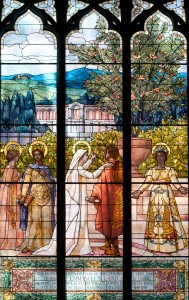The Emmanuel’s Land window graces the wall opposite our main entrance, above where the altar once stood before the nave was reoriented in 1898. One of Frederic Crowninshield’s largest works, it is comprised of 15 panels of leaded glass with 17 smaller sections of tracery above, not including the tiny lights, or openings filled with just a few pieces of glass. The larger panels are representative of the luxurious, painterly windows typical of the American Opalescent Style of John LaFarge, Louis Comfort Tiffany, and Crowninshield. Many of the latter’s windows reside in local sites, including Grace Episcopal Church in New Bedford and Memorial Hall at Harvard. The colors of the glass can rarely be matched today. Where faces, garments and hands are painted and shading is used, the style is very soft and realistic, much like the portraiture of the time. The paints used often were not fired into the glass as is common in standard windows, so special care must be taken in their cleaning and restoration. Our window exhibits a lot of “ripple” and spotted “cat’s paw” glass. Another feature common to opalescent windows is their layering, which gives strong, dimensional shading and hazy effects.
Structure
The vertical stacks of panels within the window frame are called lancets. The panels are separated by iron T-shaped bars secured to the window frame. The panels themselves are reinforced further by round horizontal bars also secured to the window frame. The bars are held to the glass by myriad copper wire ties that are soldered to lead joints in the window panel. The glass in the window, which was cut from patterns created from full-size cartoons of the composition, is held together by lead cames, extruded typically in H-shaped sections to receive glass on both sides. These are wrapped around the glass, fitted together like a jigsaw puzzle, and soldered at the joints. Stained glass is usually crafted with lead containing strengthening trace elements that make it strong enough when first completed.
Meaning
Showing the way to Emmanuel’s Land, or paradise, the window symbolizes the spiritual journey that is central to the church’s mission. Building on the theme of our banner: “Welcome wherever you are on your spiritual journey”, it symbolizes guidance for seekers of truth and light.
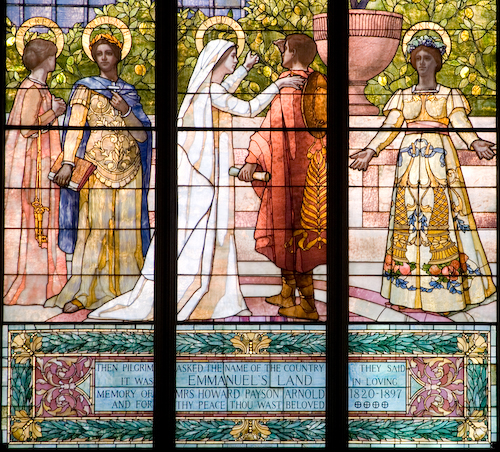
Piety, flanked by Discretion, Prudence and Charity, shows Pilgrim Emmanuel’s Land. –photo by Matthew Griffing
The subject of the window is unusual for a church in that it does not depict a religious figure or Biblical scene. The scene is taken from John Bunyan‘s The Pilgrim’s Progress from This World to That Which Is to Come, a literary work that has shaped American religious culture since the seventeenth century.
The characters depicted represent the four virtues: Discretion, Prudence, Piety and Charity. They are guiding a Christian (a.k.a. the Pilgrim) on a pilgrimage through their allegorical world. The inscription at the base of the window reads, “Then Pilgrim asked the name of the country. They said it was Emmanuel’s Land. In loving memory of Mrs. Howard Payson Arnold. And for thy peace, thou wast beloved”. The final quotation from Ecclesiasticus 47:16 refers to King Solomon.
The edifice visible in the mid-ground is the Palace Beautiful, which the artist based on Carlo Maderno‘s Water Theater in the park of Villa Torlonia in Frascati (outside Rome). The potted lemons in the center panel and oleander evoke an Italian paradise. The mountain in the distance may have been based on one of the Berkshires, where the Crowinshields had a summer house.
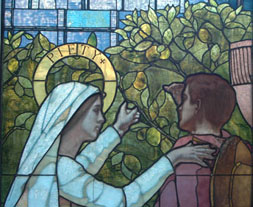
Piety shows Pilgrim Emmanuel’s Land.
History
In 1899, Frederic Crowinshield (1845-1918) designed our window in memory of his mother, Mrs. Howard Payson Arnold, who had died in 1897. Born Caroline Marie Welch in 1820, she had married his father, Edward A. Crowninshield, in 1840. He had died in 1859 at age 41. Frederic’s two brothers subsequently died in their twenties.
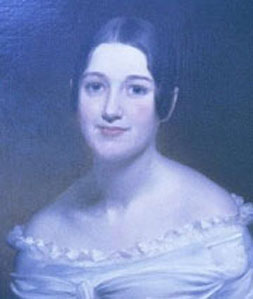
Caroline Marie Crowninshield
Crowinshield (1845-1918) taught at the Museum of Fine Arts School of Drawing and Painting, when it was housed in the basement of the Museum on Copley Square. Having studied at the Ecole des Beaux Arts in Paris and with Thomas Couture, he learned to make stained-glass through an early collaboration with Donald MacDonald, a Boston designer.
Restoration
On January 13, 2008, the main window of our historic church was re-dedicated. Entitled “Emmanuel’s Land”, but often referred to as the “Pilgrim’s Progress Window”, it was created by Frederic Crowninshield. His great-granddaughter, Gertrude Wilmers, whose generosity sparked our successful fundraising effort, addressed the parish. After the following pictures of the restored window is a history of its creation with a description of its composition, structure and restoration process. During 2007/8, the Emmanuel community came together to raise $150,000 to restore this beautiful window, which had suffered the ravages of time.
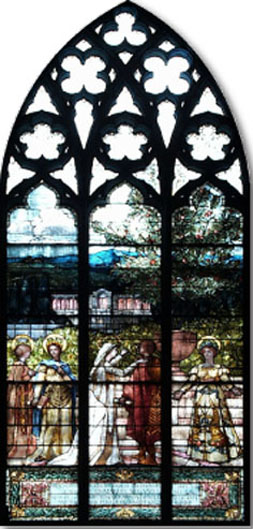
Restoration Process
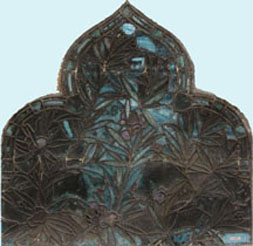
Peak section before restoration
The excess space in the lead cames is filled with putty, which dries, stiffens, and falls out over time and causes the panels to buckle. Also, the lead may stretch due to temperature changes and wind pressures, which move the window slightly. In the case of our window, bowing was most noticeable in the center, in the panels with the most lead. The buckling in and out resulted in the glass literally jutting out of the cames, creating the bright holes visible as specks of light.
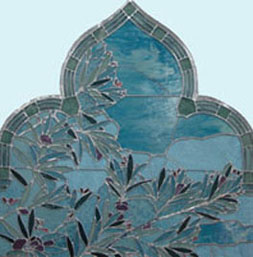
Restored peak section in reflected light of the Serpentino Studio
While this process of deterioration takes a long time, experts cannot predict when a window will fail. Several years ago, in order to restrain the glass, piano wire was installed across the face of the two worst panels. In 2005, the window was removed by Serpentino Studios in order to prevent a catastrophe. By 2008, thanks to major gifts from Gertrude Wilmers and the Mygatt family, we raised about $150,000 to pay for the restoration. On January 13, 2008, our retiring priest-in-charge, the Rev. Maureen Kemesa, officiatied at the re-dedication of the resplendent window.


